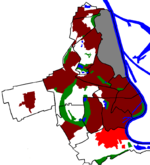Rheingönheim
|
|||
|---|---|---|---|
| coat of arms | map | ||

|

|
||
| Data | |||
| Area : | 11.01 km² | ||
| Residents : | 8,256 | ||
| Population density : | 781 inhabitants / km² | ||
| Postal code : | 67067 | ||
Rheingönheim is the southernmost district and at the same time one of the ten districts of the independent city of Ludwigshafen am Rhein in Rhineland-Palatinate . Rheingönheim currently has 8,256 inhabitants (as of August 2019).
history
During the reign of the Roman Emperor Claudius , a Roman auxiliary troop camp ( Rheingönheim Fort ) was established near Rheingönheim , which secured the river crossing at Altrip and the mouth of the Neckar (on the opposite side of the Rhine ), which was at this height at the time. During excavations in 1912 and 1961, numerous objects were recovered from around 400 graves.
Rheingönheim could be identical to the Roman-Germanic settlement Rufiniana , which the Greek geographer and astronomer Ptolemy mentions around 150 in his " Geographike Hyphegesis " as a settlement of the Nemeter in the Roman province of Germania superior . However, it is more likely to be located in the Palatinate city of Eisenberg , where a vicus with iron production indicates a strong Roman presence and settlement.
Rheingönheim was first mentioned in a document in 831 in the “Golden Book” of the Prüm Abbey .
On December 31, 1889, the cathedral capitular Philipp von Pfeiffer (1830–1908) from Speyer donated his entire private fortune to the amount of 14,968 gold marks to finance the establishment of the Catholic parish of St. Joseph in Rheingönheim.
On January 1, 1930 Rheingönheim ceded parts of the area to form the new Limburgerhof community.
In 1938 Rheingönheim was incorporated into Ludwigshafen.
In 1945 the American armed forces set up a prisoner-of-war camp ( Rheinwiesenlager ). The former soldiers were held here in a confined space until they were transferred to other camps. A memorial stone at the intersection of the K7 district road with the Brückweg commemorates this camp.
politics
Local advisory board
The political body for the local district is the Rheingönheim local council and the local councilor . The local council has seven members. He can be heard on all important questions relating to the local district.
For the composition of the local council, see the results of the local elections in Ludwigshafen am Rhein .
Mayor
The mayor of Rheingönheim is Wilhelm Wißmann (CDU). In the local elections on May 26, 2019 , he was confirmed in his office with 50.78% of the votes.
traffic
Rheingönheim has a train station on the Mannheim – Saarbrücken railway line that is served by the S1 line of the RheinNeckar S-Bahn .
Attractions
The Protestant Paul Gerhardt Church has a tower from the 13th century. It is the oldest surviving part of a church in Ludwigshafen. The Catholic St. Joseph Church was built in 1915 according to plans by Albert Boßlet .
museum
In the Mozart School, a museum provides information about former life in the village. It gives an insight into handicrafts, agriculture, clubs and family traditions.
wildlife Park
The Ludwigshafen Wildlife Park is located between Rheingönheim and the neighboring town of Neuhofen . Since 1963, numerous European game species have been settled in the alluvial forest in a typical environment. In the enclosures you can see bisons , aurochs , red deer , wild boars , lynxes and wild cats . The lynx enclosure was built in 1980. The first lynx were also introduced that year. 300 plant species and 95 bird species were also registered in the landscape protection area.
literature
- City archive of the city of Ludwigshafen am Rhein, Stefan Mörz , Klaus Jürgen Becker (eds.): History of the city of Ludwigshafen am Rhein: Vol. 1. From the beginnings to the end of the First World War . Ludwigshafen am Rhein 2003, ISBN 3-924667-35-7 .
- Dieter Bauer: Rheingönheim. From the Stone Age to the Modern Age. Historical view of a village, supplemented by maps and documents . Self-published, Ludwigshafen 1991.
- Matthias Kolb: The Roman burial ground of Rheingönheim . Dissertation, University of Mannheim 2006 ( full text ).
- Günter Ulbert : The early Roman fort Rheingönheim. The finds from 1912 and 1913 . Mann, Berlin 1969.
Individual evidence
- ↑ a b c Rheingönheim district pass. (PDF) August 2019, accessed on May 2, 2020 .
- ↑ a b Wilhelm Volkert (Ed.): Handbook of the Bavarian offices, communities and courts 1799–1980 . CH Beck, Munich 1983, ISBN 3-406-09669-7 , p. 515 .
- ^ City of Ludwigshafen am Rhein: Main statute for the city of Ludwigshafen am Rhein. § 2, main statute of July 22nd, 1974, last amended by statute of May 15th, 2019. Retrieved October 10, 2019 .
- ^ The regional returning officer RLP: direct elections 2019. Ludwigshafen, see tenth line of results. Retrieved October 10, 2019 .
- ↑ Rheingönheim Wildlife Park ( Memento from September 30, 2017 in the Internet Archive )
Web links
- Literature about Rheingönheim in the Rhineland-Palatinate state bibliography
Coordinates: 49 ° 26 ′ 48 ″ N , 8 ° 25 ′ 9 ″ E






